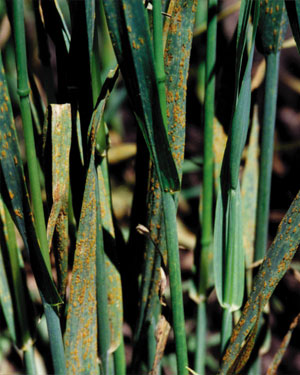
Crown rust (Puccinia coranata) was found in over 3000 acres of oats in Levy, Suwannee and Madison counties in the last week. The most notable characteristic of the fungus is small pustules which contain orange-yellow spores. Rubbing the leaf with your fingers or a towel will leave a fine orange powder.
These pustules block sunlight from reaching the leaf and inhibit photosynthesis. Severe cases can be fatal to the plant; lesser infestations still seriously reduce forage yields. The disease thrives in warm (50-80 degrees F), moist conditions and is considered one of the most serious diseases of oats. Spores are distributed by wind and can move long distances easily. The spores overwinter in warmer southern climes and move back on the wind to northern states in the summer.
This particular strain of crown rust is affecting all varieties of southeastern oats, so regular scouting of oats for this disease is recommended. Early diagnosis is key. If identified or suspected, contact the local UF/IFAS County Extension agent to confirm the diagnosis.
Heavy grazing pressure can reduce the amount of fungal inoculant on the oat crop. The spores will not affect the grazing livestock. Excessive grazing itself can kill or stunt oat cropss, so monitor grazing to ensure the treatment is not as bad as the disease.
There are fungicides labeled for control of crown rust, however, they should only be used with confirmed infection. Several fungicides are limited to only one or two applications per season. Also, with a fungicide cost of at least $10 per acre, plus the application cost of at least $5/acre, it is critical to be sure fields are actually infected and do require treatment. Follow the label directions, each of the fungicides have at least a seven day grazing withdrawal period, based on recommendations from NCERA-184, the North Central Regional Committee on Management of Small Grain Diseases.
No matter how crown rust is managed, winter feeding programs will be disrupted. Consider using commodity feeds or over-seeding ryegrass to supply the critical needs of the herd. Failure to maintain animal performance will continue the economic impact of crown rust long after warm season pastures return.
Further information about crown rust is available at the USDA Crown Rust website, or by contacting your County Extension Agent.

 0
0
